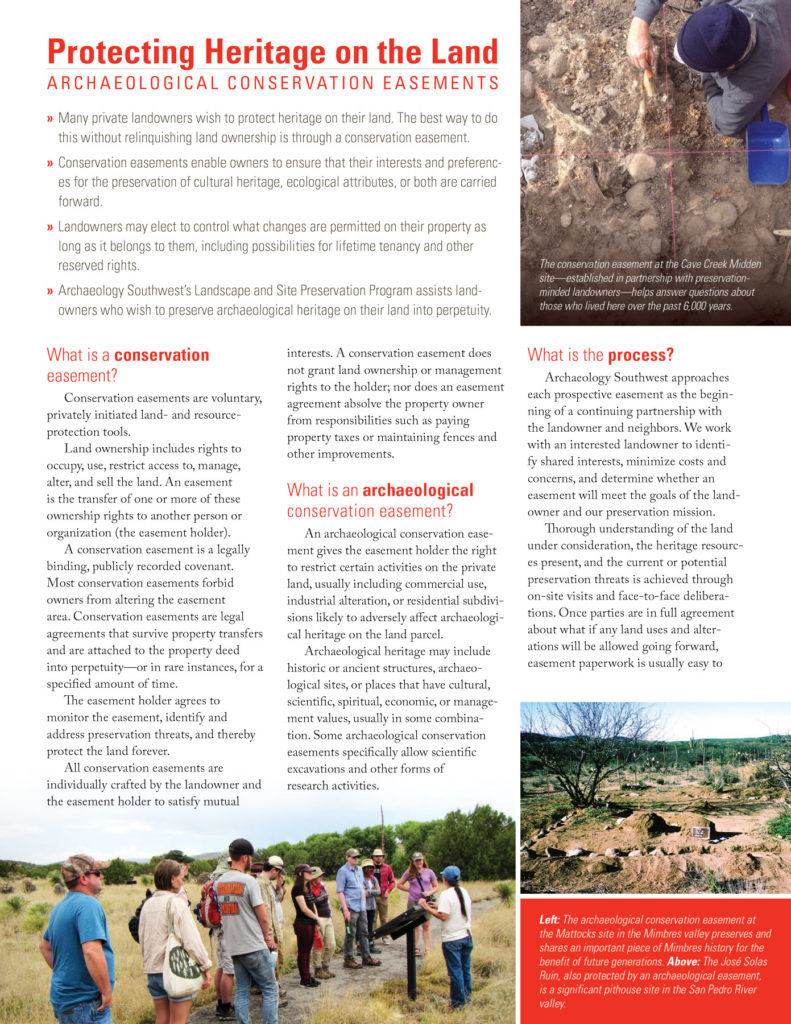
- Many private landowners wish to protect heritage on their land. The best way to do this without relinquishing land ownership is through a conservation easement.
- Conservation easements enable owners to ensure that their interests and preferences for the preservation of cultural heritage, ecological attributes, or both are carried forward.
- Landowners may elect to control what changes are permitted on their property as long as it belongs to them, including possibilities for lifetime tenancy and other reserved rights.
- Archaeology Southwest’s Landscape and Site Preservation Program assists landowners who wish to preserve archaeological heritage on their land into perpetuity.
What is a conservation easement?
Conservation easements are voluntary, privately initiated land- and resource- protection tools.
Land ownership includes rights to occupy, use, restrict access to, manage, alter, and sell the land. An easement is the transfer of one or more of these ownership rights to another person or organization (the easement holder).
A conservation easement is a legally binding, publicly recorded covenant. Most conservation easements forbid owners from altering the easement area. Conservation easements are legal agreements that survive property transfers and are attached to the property deed into perpetuity—or in rare instances, for a specified amount of time.
The easement holder agrees to monitor the easement, identify and address preservation threats, and thereby protect the land forever.
All conservation easements are individually crafted by the landowner and the easement holder to satisfy mutual interests. A conservation easement does not grant land ownership or management rights to the holder; nor does an easement agreement absolve the property owner from responsibilities such as paying property taxes or maintaining fences and other improvements.
What is an archaeological conservation easement?
An archaeological conservation easement gives the easement holder the right to restrict certain activities on the private land, usually including commercial use, industrial alteration, or residential subdivisions likely to adversely affect archaeological heritage on the land parcel.
Archaeological heritage may include historic or ancient structures, archaeological sites, or places that have cultural, scientific, spiritual, economic, or management values, usually in some combination. Some archaeological conservation easements specifically allow scientific excavations and other forms of research activities.
What is the process?
Archaeology Southwest approaches each prospective easement as the beginning of a continuing partnership with the landowner and neighbors. We work with an interested landowner to identify shared interests, minimize costs and concerns, and determine whether an easement will meet the goals of the land- owner and our preservation mission.
Thorough understanding of the land under consideration, the heritage resources present, and the current or potential preservation threats is achieved through on-site visits and face-to-face deliberations. Once parties are in full agreement about what if any land uses and alterations will be allowed going forward, easement paperwork is usually easy to prepare.
Who may grant a conservation easement?
The landowner is the only one who may decide to place a conservation easement on their property. When a property is owned by several individuals, all owners must agree to place the conservation easement. If the property has been mortgaged, the mortgage holder must also agree to the conservation easement.
What are the benefits?
- Preservation into perpetuity: Heritage and scientific values must be preserved by future owners.
- Retention of private ownership: The property owner is free to sell, lease, rent, or bequeath the property.
- Case-by-case specificity and flexibility: Easements are custom-crafted to meet the specific needs and circumstances of the property owner, the heritage resources, and Archaeology Southwest’s goals.
- Financial benefits: Conservation easement donors are often eligible for federal and state income and estate tax benefits. Prospective easement donors should consult an attorney or tax accountant with expertise in conservation easements to determine the tax implications of donating or selling a conservation easement. Property tax benefits vary state by state, and sometimes county by county. New Mexico, for example, offers substantial state tax credits for qualifying easements.
What are the responsibilities of the easement holder?
Whether the easement holder is a public institution or a nonprofit organization, the holder is responsible for enforcing requirements stipulated in the easement. Responsibilities generally include:
- Developing easement documents that are clear and enforceable.
- Documenting the conservation easement so as to describe property conditions at the time of the easement donation or sale.
- Monitoring the easement through property visits and open communications with the landowner and neighbors to ensure that easement restrictions are being upheld.
- Providing background information and easement rights and restrictions to new and prospective property owners.
- Establishing a review process for proposed land uses that may require prior approval, as stipulated in the original easement.
- Enforcing the restrictions of the easement, including through the legal system, if necessary.
- Maintaining easement-related records.
CONTACT INFO:
John Welch, Landscape and Site Preservation Program Director
email
(520) 894-6471